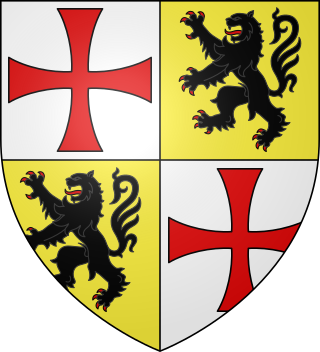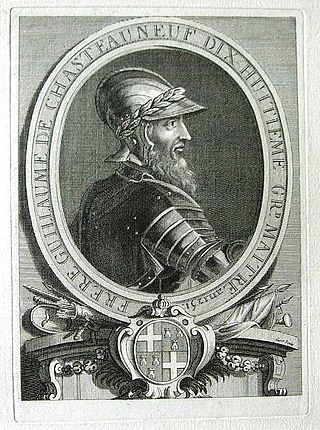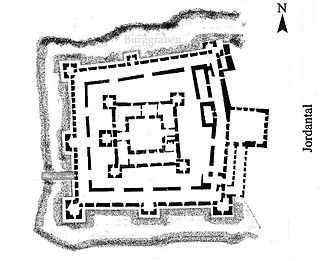
The Third Crusade (1189–1192) was an attempt led by three European monarchs of Western Christianity to reconquer the Holy Land following the capture of Jerusalem by the Ayyubid sultan Saladin in 1187. For this reason, the Third Crusade is also known as the Kings' Crusade.
Roger de Moulins was the eighth Grand Master of the Knights Hospitaller from 1177 until his death in 1187. He succeeded Jobert of Syria. His successors were two interim masters, William Borrel and then Armengol de Aspa, before the permanent Grand Master Garnier of Nablus was selected in 1190.

Gérard de Ridefort, also called Gerard de Ridefort, was Grand Master of the Knights Templar from the end of 1184 and until his death in 1189.

Raymond du Puy (1083–1160) was a knight from Dauphiné in France and the second Grand Master of the Knights Hospitaller, also known as the Order of St. John of Jerusalem, from around 1121 until 1160. Officially, he succeeded Blessed Gerard, the founder of the Order, as Grand Master. While traditionally cited as the direct successor upon Gerard's death in 1118 or 1120, his assumption of the magisterium was in 1121 or 1123 after one or two interim superiors, Pierre de Barcelona and Boyant Roger. Raymond divided the membership of the Order into clerical, military, and serving brothers and established the first significant Hospitaller infirmary near the Church of the Holy Sepulchre in Jerusalem.

Guérin de Montaigu, also known as Garin de Montaigu or Pierre Guérin de Montaigu, was a nobleman from Auvergne, who became the fourteenth Grand Master of the Knights Hospitaller, serving from 1207–1228. He succeeded the Grand Master Geoffroy le Rat after his death in 1206, and was succeeded by Bertrand de Thessy.

Gilbert of Assailly was the fifth Grand Master of the Knights Hospitaller, serving from 1162 or 1163 to 1170, when he was deposed. As Grand Master, he succeeded Auger de Balben. Nevertheless, most sources list him as the fifth, rather than fourth, Grand Master and this biography continues that tradition, with the exception being Delaville Le Roulx' work. He was succeeded by Gastone de Murols. Gilbert encouraged Amalric of Jerusalem in his unsuccessful invasion of Egypt, leaving the Order in debt and causing the reexamination of its military role.

Jean de Villiers was the twenty-second grand master of the Knights Hospitaller, serving from 1285 until 1293. He was elected Grand Master after the death of Nicolas Lorgne. De Villiers was Prior of France beginning in 1282 and he remained in France to deal with existing problems of the Order. Jacques de Taxi became Grand Master ad interim, perhaps through 27 June 1286, while awaiting the arrival of the newly elected Grand Master in the Holy Land. De Villiers was present at the Siege of Acre in 1291, but escaped just before the city fell to the Mamluks. He was succeeded by Odon de Pins.

Garnier de Nablus, also known as Garnier of Syria, was the tenth Grand Master of the Knights Hospitaller from 1190 to 1192, succeeding Armengol de Aspa. He fought at the Battle of Arsuf in 1191 during the Third Crusade. It was under his magistracy that the headquarters of the Order were transferred from Tyre to Acre. He was succeeded by Geoffroy de Donjon.
Master Sibrand was the founder of the hospital in Akkon, which was to become the base of the Teutonic Knights. For this reason, he is sometimes considered the "first grand master" of that order, even if it was only given recognition in 1192, and transformed into a military order in 1198.

Nicolas Lorgne was the twenty-first Grand Master of the Knights Hospitaller, serving first from 1277 until 1285 and was the successor to Hugues de Revel. He was succeeded by Jean de Villiers, with Jacques de Taxi acting as Grand Master ad interim while de Villiers was en route to the Holy Land.

Hugues de Revel was an English knight who became the twentieth Grand Master of the Knights Hospitaller, serving from 1258 to 1277 as the successor to Guillaume de Chateauneuf. He was succeeded by Nicolas Lorgne.

Geoffroy de Donjon, also known as or Geoffroy de Duisson, was the eleventhth Grand Master of the Knights Hospitaller serving from 1193 through his death in 1202. He succeeded Garnier de Nablus who died in August 1192.

Pierre de Vieille-Brioude, or Vieille-Bride, was a nobleman from Auvergne who was the eighteenth Grand Master of the Knights Hospitaller between 1240 and 1242, succeeding Bertrand de Comps. He was succeeded by Guillaume de Chateauneuf.

Guillaume de Chateauneuf was the nineteenth Grand Master of the Knights Hospitaller, serving first from 1242–1244 as the successor to Pierre de Vieille-Brioude. He was captured during the Battle of La Forbie in 1244, held hostage in Egypt and ransomed through the Sixth Crusade. During his captivity, his position was filled on an interim basis by Jean de Ronay. De Ronay died in 1250, and de Chateauneuf was released shortly thereafter. He was succeeded by Hugues de Revel.

Guérin Lebrun was the sixteenth Grand Master of the Knights Hospitaller, serving between 1228 and 1231. He succeeded Bertrand de Thessy in 1230 or 1231. As he was Prior of France, he was likely from France and is generally referred to by the single name of Guérin. He was succeeded by Bertrand de Comps.
Jean de Ronay was knight of the Order of Saint John of Jerusalem who was appointed Grand Commander of the Knights Hospitaller by the Grand Master Guillaume de Chateauneuf in 1243 or 1244. He served as interim Grand Master of the Knights Hospitaller from 1244 to 1250 during the captivity of de Chateauneuf. He died in battle during the Seventh Crusade.
William Borrel was acting Grand Master of the Knights Hospitaller, ad interim, from 1 May 1187 until his death at the Battle of Hattin in 1187. He became custodian of the Hospitallers after the Grand Master Roger de Moulins was killed in the Battle of Cresson on 1 May 1187.
The history of the Knights Hospitaller in the Levant is concerned with the early years of the Order of the Hospital of St. John of Jerusalem, the Knights Hospitaller, through 1309. The Order was formed in the later part of the eleventh century and played a major role in the Kingdom of Jerusalem, in particular, the Crusades. This lasted until the West was expelled from the Holy Land, with the Order conquering Rhodes in the early fourteenth century. Among the most important internal events of the early years of the kingdom were the foundation of the Military Orders, which included the Hospitallers, the Knights Templar and the Teutonic Order. Unlike the Hospitallers' beginnings as a benevolent organization, the Templars and Teutonic knights began with a military mission. These three major Orders would play a major role in the military activities of the kingdom, sometimes cooperatively, sometimes not. On the battlefield they frequently shared among them the most important tactical roles, the vanguard and rear-guard.

In late 1187, the Ayyubids, led by Saladin, besieged the Hospitallers fortress of Belvoir Castle for an entire year before the Ayyubid forces were successful.














